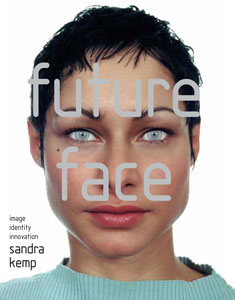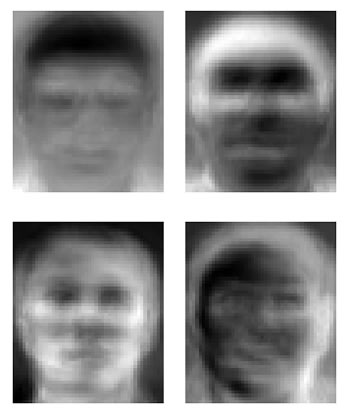Science Fiction
Dictionary
A B C D E F G H I J K L M N O P Q R S T U V W X Y Z
Future Face - The Principal Eigenface?

Future Face, an exhibition at London's Science Museum, asks this question: Will the widespread use of digital enhancement to "improve" faces in photographs suggest the kind of face that people will have in the future?
Sandra Kemp, the exhibit curator, is a leading academic in visual culture. She notes that many people no longer have "sticky photo albums" - that is, they no longer have hard copy output of their pictures. Instead, pictures are held in digital format and viewed on computer screens or televisions. She points out that these pictures can be photoshopped at will and "people are enhancing their faces all the time." She states:
"We are subtly being conditioned by the digital face and heading towards a face which no human being could have been born with. This face is smooth and narrow, with a small jaw, big lips and manga Japanese eyes for the females."

(From Future Face Book)
It is an odd coincedence that we should have the technology to alter this most important of human identifiers at exactly the same time that we are working hard to develop face recognition technologies. After all, your face is your most frequently used ID - you show it everywhere you go. We are hardwired for biometric face recognition. Newborn infants have been shown to track faces immediately.
Face recognition software typically works by using a set of eigenfaces, which are essentially standardized facial features derived from a statistical analysis of many pictures of faces. A large sample of digital images of human faces, lined up at the eyes and mouths, is sampled at the same pixel resolution. The principal eigenface in a set looks like a fuzzy averaged androgenous human face. The others add the necessary variations.

(From Eigenface)
Many of us who have digital photo albums with simple photo-editing software have done "clean-up jobs" on our faces, or those of our loved ones. People who have plastic surgery done are just "photoshopping" their actual face. What happens when more and more people seek an idealized look, an average of the most beautiful faces? You would get a generic beautiful face for everyone - and a lot of useless face recognition software (which has a high rate of failure even now, with all of our different, imperfect faces).
Science fiction writer William Gibson, in his novel Count Zero, had a pretty good handle on this idea in 1986 when he refers to a sort of statistical beauty; an average of pretty faces:
"He would have expected a routine beauty, bred out of cheap elective surgery and the relentless Darwinism of fashion, an archetype cooked down from the major media faces of the previous five years...Early work on computerized face recognition was done in the 1960's; the first work on eigenfaces was done in 1989. A number of face recognition products exist today; you may see some of them at Customs desks around the world.The faces ... were like God's own hood ornaments."
Read more about the Future Face exhibit and article; thanks to ratchet up for the pointer; read more about eigenfaces and face recognition.
Scroll down for more stories in the same category. (Story submitted 10/22/2004)
Follow this kind of news @Technovelgy.| Email | RSS | Blog It | Stumble | del.icio.us | Digg | Reddit |
Would
you like to contribute a story tip?
It's easy:
Get the URL of the story, and the related sf author, and add
it here.
Comment/Join discussion ( 1 )
Index of related articles:
Biometric security overview
Biometrics Glossary
Characteristics of successful biometric identification methods
Biometric identification systems
Biometric technology on the leading edge
Biometric identification - advantages
Biometric security and business ethics
Biometric authentication: what method works best?
Iris Recognition
Iris Scan
Related News Stories - (" Culture ")
Indonesian Clans Battle
'The observation vehicle was of that peculiar variety used in conveying a large number of people across rough terrain.' - Jack Vance (1952)
Liuzhi Process Now In Use In China
'He was in a high-ceilinged windowless cell with walls of glittering white porcelain.' - George Orwell, 1984.
Animated Tumblebugs On Astounding Cover!
'Gaines and Harvey mounted tumblebugs, and kept abreast of the Cadet Captain...'
Has Elon Musk Given Up On Mars?
'There ain't no such thing as a free lunch.'
Technovelgy (that's tech-novel-gee!) is devoted to the creative science inventions and ideas of sf authors. Look for the Invention Category that interests you, the Glossary, the Invention Timeline, or see what's New.
Science Fiction
Timeline
1600-1899
1900-1939
1940's 1950's
1960's 1970's
1980's 1990's
2000's 2010's
Current News
Proof Of Robothood - Not A Person
'Who are you people? - Show 'em.'
Dancing Robots Taught Dance Moves
'A clockwork figure would be the thing for you...'
Indonesian Clans Battle
'The observation vehicle was of that peculiar variety used in conveying a large number of people across rough terrain.'
The 'Last Mile' In China Crowded With Delivery Robots
Yes, it's a delivery robot. On wheels.
Tornyol Microdrone Kills Mosquitoes
'The real border was defended by... a swarm of quasi-independent aerostats.'
PLATO Spacecraft, Hunter Of Habitable Planets, Now Ready
'I ... set my automatic astronomical instruments to searching for a habitable planet.'
Factory Humanoid Robots Built By Humanoid Robots
'...haven't you a section of the factory where only robot labor is employed?'
iPhone Air Fulfils Jobs' Promise From 2007 - A Giant Screen!
'... oblongs were all over the floor and surfaces.'
ChatGPT Now Participates in Group Chats
'...the city was their laboratory in human psychology.'
iPhone Pocket All Sold Out!
'A long, strong, slender net...'
Did The Yautja Have These First?
What a marvel of ingenuity the little device was!
Jetson ONE Air Races Begin, Can Air Polo Be Far Behind?
'If you're one of those rarities who haven't attended a rocket-polo "carnage", let me tell you it's a colorful affair.'
Will Space Stations Have Large Interior Spaces Again?
'They filed clumsily into the battleroom, like children in a swimming pool for the first time, clinging to the handholds along the side.'
Mornine Sales Robot
'Robot-salesmen were everywhere, gesturing...'
Bipedal Robot Floats Gently While Walking
'a walking balloon proceeded with long strides of its aluminum legs...'
Musk Idea Of Cars Talking To Each Other Predicted 70 Years Ago
'My cars talk to one another.'
